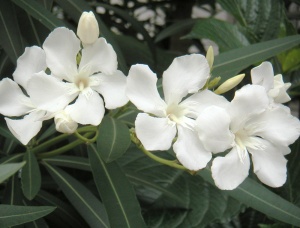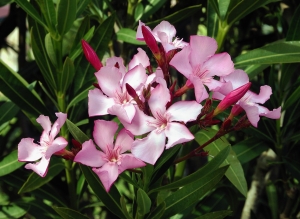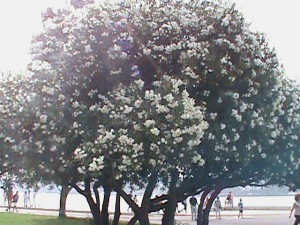By Liliana Usvat
When you see the same plant over and over again in a country you might ask yourself. What is the use of that plant except the shade it provides.
Its smell is believed to repel both rodents and insects when simply planted in the garden. The plant is often grown in the garden or a container. It grows well in both full sunlight and partial shade. It has a very high drought tolerance, and grows well in high salt coastal areas.
Oleander is the official flower of the city of Hiroshima, having been the first to bloom following the atomic bombing of the city in 1945
Site Selection
Ideally, select a site with full sun to light shade and well-drained soil. However, oleanders are adaptable and will withstand dry conditions as well as marshy soils.
Propagation
It is very easy to propagate from oleander cuttings. There are two good ways…one says to use the hard wood, while the other says that tip cuttings are the best. You can use either way and still be successful.Make your cuttings about 6′ long each and remove the lower leaves. The location of the bottom three leaf nodes is where your roots will start, although they will progress elsewhere. Cut the remaining upper leaves to about one inch long. You can place these in water by themselves, or put in a small twig of willow – which acts as a stimulator – long with the cuttings in the water. After the roots grow to between one and two inches long, transplant inot some good draining soil. Keep it moist, but not wet, and in a mostly sunny location.Another method is to dip the bottom end of your cutting in ROOTONE and plant it in some sande.Either method should bring results in about two weeks. In about a year, these will have grown to gallon size and continue from there. Don’t forget to prune them after they reach the gallon size so you get the shape and stucture you want
Planting Instructions
Plant in spring or fall. Space plants 6 to 12 feet apart, depending on variety. Dig a hole only as deep as the root ball and 2 to 3 times as wide. If your soil is in very poor condition, amend the soil you’ve removed from the hole with a small amount of compost. Otherwise don’t amend it at all. Carefully remove the plant from the container and set it in the hole. Fill the hole half full with soil, then water it well to settle the soil and eliminate air pockets. Let the water drain, then fill the remainder of hole with soil and water thoroughly.
Care
Apply a layer of compost under the plant each spring, spreading it out to the dripline (the area under the outermost branches). Add a 2-inch layer of mulch to retain moisture and control weeds. Water plants during the summer if rainfall is less than 1 inch per week. Prune oleander after the main bloom period to encourage bushier growth and more flowers, and to reduce the size of the shrub.
Nerium oleander has historically been considered a poisonous plant because some of its compounds may exhibit toxicity, especially to animals, when consumed in high amounts. Among these compounds are oleandrin and oleandrigenin, known as cardiac glycosides, which are known to have a narrow therapeutic index and can be toxic when ingested.
Drugs derived from Nerium oleander have been investigated as a treatment for cancer
Nerium oleander is an evergreen shrub or small tree in the dogbane family Apocynaceae, toxic in all its parts. It is the only species currently classified in the genus Nerium. It is most commonly known as oleander, from its superficial resemblance to the unrelated olive Olea. It is so widely cultivated that no precise region of origin has been identified, though southwest Asia has been suggested.
Oleander grows to 2–6 m (6.6–20 ft) tall, with erect stems that splay outward as they mature; first-year stems have a glaucous bloom, while mature stems have a grayish bark. The leaves are in pairs or whorls of three, thick and leathery, dark-green, narrow lanceolate, 5–21 cm (2.0–8.3 in) long and 1–3.5 cm (0.39–1.4 in) broad, and with an entire margin.
The flowers grow in clusters at the end of each branch; they are white, pink to red,2.5–5 cm (0.98–2.0 in) diameter, with a deeply 5-lobed fringed corolla round the central corolla tube.
They are often, but not always, sweet-scented. The fruit is a long narrow capsule 5–23 cm (2.0–9.1 in) long, which splits open at maturity to release numerous downy seeds.
Meaning & History
From the Greek Λεανδρος (Leandros) which means “lion of a man” from Greek λεων (leon) “lion” and ανδρος (andros) “of a man”. In Greek legend Leander was the lover of Hero. Every night he swam across the Hellespont to meet her, but on one occasion he was drowned when a storm arose. When Hero saw his dead body she threw herself into the waters and perished.
Medicine Treatment of Cancer. Hepatitis C, Psoriasis
A decoction of the leaves and stems of a plant very common Oleander. 12 l of water and leaves and stems oleander slices cooked for 4 hours.
After 4 h take the leaves and stems, and strained the remaining broth, using paper towels and plastic strainers. Leave the broth to cool before straining. Then soup simmered until the liquid initially remained only 5% in the bottom 12 liter pot.
Took oral doses three times daily with meals, the only side effect is diarrhea, which subsided after a week.
Analysis made three weeks later were surprising, showing that tumors continue to shrink and almost gone. A month later, the person had no tumors at all. It is about as thick as chicken soup.
Mexican doctors treating poor patients suffering from AIDS, cancer, hepatitis C, psoriasis, rheumatoid arteritis using homeopathic remedy.
Oleander is sometimes applied to the skin to treat skin problems and warts.
Blog 100-365
Related articles
- Proper Care Techniques for an Oleander Bush Grown in Phoenix (local.answers.com)
- Nerium oleander (Korobi) (findmeacure.com)
- Nerium (en.wikipedia.org)
- My first Nerium Oleander (sandiegonerium.wordpress.com)
- Nerium ~ Oleander Plant Care Guide (auntiedogmasgardenspot.wordpress.com)
- Plants in Provence – the Oleander (thewisethrush.wordpress.com)
- Nerium oleander- Nerium AD’s toxic active (sandiegonerium.wordpress.com)
- How the properties of Nerium oleander took clinical trials by storm (neriumjohn.wordpress.com)
- Nerium Skin Care (sandiegonerium.wordpress.com)
- Oleander (villagecraftsmen.blogspot.com)



